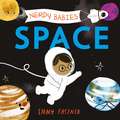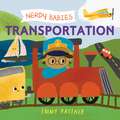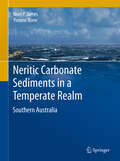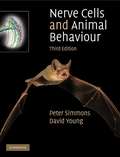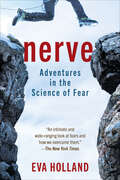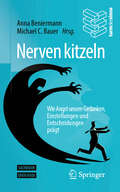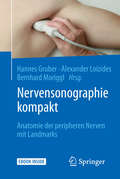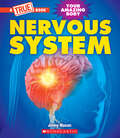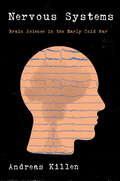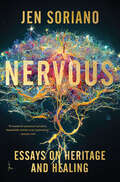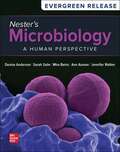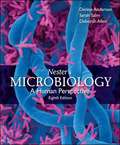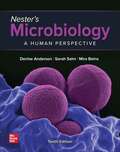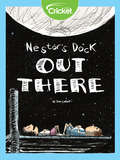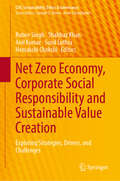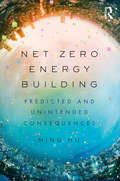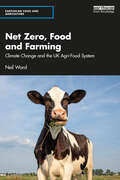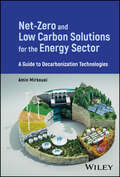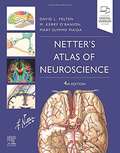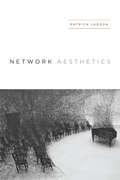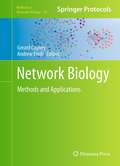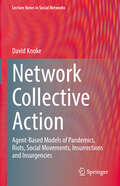- Table View
- List View
Nerdy Babies: Space (Nerdy Babies #2)
by Emmy KastnerNerdy Babies is a new series that will ignite curiosity in even the youngest readers and encourage them to ask questions and explore the world around them.In Nerdy Babies: Space, follow our intrepid infants into the great unknown. Check out the moon and the sun and all the planets in our solar system. Plus, learn about gravity and orbits in this simple text written in question and answer format. With bright artwork by Emmy Kastner, this will be a book that the very littlest nerds will want to return to again and again. Stay curious. There’s more to learn about everything!
Nerdy Babies: Transportation (Nerdy Babies)
by Emmy KastnerNerdy Babies is a series that will ignite curiosity in even the youngest readers and encourage them to ask questions and explore the world around them.In Nerdy Babies: Transportation, follow our intrepid babies when they’re on the go. Experience skating on rollerblades, flying on air balloons, exploring underwater in a submarine, and riding cross-country on a car. Plus, learn about how different air, land, and sea travel can be in this simple text written in question-and-answer format.With bright artwork by Emmy Kastner, Nerdy Babies is a series that the very littlest nerds will want to return to again and again.Stay curious. There’s more to learn about everything!
Neritic Carbonate Sediments in a Temperate Realm
by Noel P. James Yvonne BoneThis book is the first comprehensive documentation and interpretation of modern neritic carbonate sediments on the southern Australian continental margin, the largest cool-water carbonate depositional system on the globe. The approach is classical but the information is new. A brief chapter of introduction is followed by a section that describes the setting of the continental margin in terms of the regional geology, its evolution through time, the climate, and the complex oceanography. The setting is further explored in chapter 3 that outlines the Pleistocene history of sedimentation in this region. This is particularly important since many of the surficial sediments have a partial older history. The following section on the carbonate factory describes in detail the nature of the animals and plants that determine the nature of the sediments and the environmental conditions that control their distribution. The shelf itself cannot be discussed in isolation and thus a short chapter on the marginal marine environment is presented. The core of the book comprises two chapters that document the suite of depositional facies and their composition and then the suite of depositional environments where these sediments are found. The variety of deposits in this vast area is such that three chapters are devoted to the character of the materials on the southwestern shelf the south Australian sea and the southeastern shelf. The diagenesis that affects these sediments is tackled in a chapter after all the attributes are documented because they are intimately linked to different controls. The book finishes with a summary chapter that also addresses the various controls on sedimentation and models the effects to be expected when these are changed outside those present in the current realm. Audience: The book is an invaluable source of information about this vast region and will be a critical reference for researchers, graduate students, and professionals engaged in marine and environmental research. It will be of particular importance for geologists interpreting the ancient rock record.
Nerve Cells and Animal Behaviour
by David Young Peter SimmonsAn extensively revised third edition of this introduction to neuroethology - the neuronal basis of animal behaviour - for zoology, biology and psychology undergraduate students. The book focuses on the roles of individual nerve cells in behaviour, from simple startle responses to complex behaviours such as route learning by rats and singing by crickets and birds. It begins by examining the relationship between brains and behaviour, and showing how study of specialised behaviours reveals neuronal mechanisms that control behaviour. Information processing by nerve cells is introduced using specific examples, and the establishing roles of neurons in behaviour is described for a predator-prey interaction, toads versus cockroaches. New material includes: vision by insects, which describes sensory filtering; hunting by owls and bats, which describes sensory maps; and rhythmical movements including swimming and flying, which describes how sequences of movements are generated. Includes stunning photographs which capture the detail of the behaviour.
Nerve-Muscle Cell Trophic Communication (Routledge Revivals)
by Hugo L. FernandezFirst Published in 1988, this book offers a full, comprehensive guide to the relationship between nerve endings and muscles and the ways in which they communicate. Carefully compiled and filled with a vast repertoire of notes, diagrams, and references this book serves as a useful reference for students of medicine, and other practitioners in their respective fields.
Nerve: Adventures in the Science of Fear
by Eva HollandAward–winning, bestselling journalist Eva Holland’s Nerve is “an intimate and wide-ranging look at fears and how we overcome them” (New York Times).A TIME Top 100 Must Read Since childhood, Eva Holland has been gripped by two debilitating phobias: fear of losing her mother and fear of heights. The worst comes to pass with her mother’s sudden death in 2015, and something shifts for Eva. Then, when an ice-climbing expedition ends with Eva embarrassed and in tears, a new resolve kicks in: Fear may define her past, but it won’t decide her future! Through incredibly moving storytelling and boots-off-the-ground investigation, Holland peels back the layers of paralyzing dread to ask: Is fear necessary? Is it rooted in the body or the mind? And even: Is there a better way to feel afraid? By grappling with, even embracing, her innermost dreads, Holland aspires to give us all the nerve to face down the phobias that limit our lives. “The publication of Nerve could be one of the most germane and significant books to help people navigate through our current dark and unfamiliar emotional and physical territory. With acuity of purpose, author Holland demonstrates to her audience that armed with a baseline of knowledge, fear is an emotion that can be experienced, examined, and conquered, thereby strengthening the human psyche and its ability to deal with future catastrophes.” —New York Journal of Books“Nerve is brave and tender, and an example of why journalists treating themselves as guinea pigs should never completely go out of style.” —WIRED
Nerven kitzeln: Wie Angst unsere Gedanken, Einstellungen und Entscheidungen prägt
by Michael C. Bauer Anna BeniermannWir schlottern vor Angst, wollen fliehen oder erstarren – keine Frage, Angst ist eine der wichtigsten menschlichen Grundemotionen, und jede*r kennt die Macht, die sie über uns haben kann. So unangenehm sie ist: Evolutionär gesehen hat sie eine wichtige Funktion. Denn sie schützt uns, indem sie unsere Aufmerksamkeit auf mögliche Gefahren lenkt. Angst löst in gefährlichen Situationen angemessenes Verhalten, wie Flucht oder Abwehr, aus, sie schärft unsere Sinne und bringt uns in Höchstform.Welche Bedeutung Angst hat, welche physiologischen Prozesse ihr zugrunde liegen und wie sie insbesondere aus der Sicht der Hirnforschung und Psychologie entsteht und wirkt, steht im Mittelpunkt dieses Buches. Renommierte Experten verschiedener Fachgebiete von Neurologie über Psychologie und Pädagogik bis zur Soziologie beleuchten, wie Ängste unser Verhalten beeinflussen – wie sie für uns zur Belastung werden, aber auch, wie sie uns einen „Kick“ geben können.
Nervensonographie kompakt: Anatomie der peripheren Nerven mit Landmarks
by Hannes Gruber Alexander Loizides Bernhard MorigglDieser Taschenatlas stellt erstmals die topographische Anatomie aller peripheren Nerven im Ultraschall mit Fokussierung auf spezielle Landmarken dar: mit den Punkten der optimalen Visibilität (POV). Annähernd alle Nerven des menschlichen Körpers sind mit hochauflösenden Schallköpfen bis zu 24 MHz im Detail dargestellt. Nützlich für den Anfänger wie für den Spezialisten-Nerven-Sonographeur, liefert dieser Atlas klare und schnelle Vorgaben über die Sono-Anatomie der Nerven. Speziell für Neurologen, Anästhesisten, Schmerztherapeuten, Radiologen, Rheumatologen und Chirurgen bietet diese standardisierte Anleitung klare Orientierung bei der Frage „Wo finde ich den Nerv am einfachsten“.
Nervous System (A True Book (Relaunch))
by Jenny MasonDiscover the main systems of our amazing human body with this new series of books!The human brain is a natural wonder = the command center that, through a network of nerves, runs every other system in our bodies. Did you know that there are 100,000,000,000 neurons in your brain? Or that your funny bone is actually a nerve in the elbow, not a bone? Learn all this and more in Nervous System.ABOUT THE SERIES:The human body is a complex = and remarkable = machine. Digesting our food. Pumping our blood. Walking, running, and dancing. It takes our many body systems working together to keep us alive and living our lives to the fullest. This set of A True Books offers an in-depth look at our amazing bodies = one system at a time. Interesting information is presented in a fun, friendly way = and in the simplest terms possible = giving students a "behind-the-scenes" look at how their bodies work.
Nervous Systems: Brain Science in the Early Cold War
by Andreas KillenIn this eye-opening chronicle of scientific research on the brain in the early Cold War era, the acclaimed historian Andreas Killen traces the complex circumstances surrounding the genesis of our present-day fascination with this organ.The 1950s were a transformative, even revolutionary decade in the history of brain science. Using new techniques for probing brain activity and function, researchers in neurosurgery, psychiatry, and psychology achieved dramatic breakthroughs in the treatment of illnesses like epilepsy and schizophrenia, as well as the understanding of such faculties as memory and perception. Memory was the site of particularly startling discoveries. As one researcher wrote to another in the middle of that decade, “Memory was the sleeping beauty of the brain—and now she is awake.” Collectively, these advances prefigured the emergence of the field of neuroscience at the end of the twentieth century.But the 1950s also marked the beginning of the Cold War and a period of transformative social change across Western society. These developments resulted in unease and paranoia. Mysterious new afflictions—none more mystifying than “brainwashing”—also appeared at this time. Faced with the discovery that, as one leading psychiatrist put it, “the human personality is not as stable as we often assume,” many researchers in the sciences of brain and behavior joined the effort to understand these conditions. They devised ingenious and sometimes transgressive experimental methods for studying and proposing countermeasures to the problem of Communist mind control. Some of these procedures took on a strange life of their own, escaping the confines of the research lab to become part of 1960s counterculture. Much later, in the early 2000s, they resurfaced in the War on Terror.These stories, often told separately, are brought together by the historian Andreas Killen in this chronicle of the brain’s mid-twentieth-century emergence as both a new research frontier and an organ whose integrity and capacities—especially that of memory—were imagined as uniquely imperiled in the 1950s. Nervous Systems explores the anxious context in which the mid-century sciences of the brain took shape and reveals the deeply ambivalent history that lies behind our contemporary understanding of this organ.
Nervous: Essays on Heritage and Healing
by Jen SorianoActivist Jen Soriano brings to light the lingering impacts of transgenerational trauma and uses science, history, and family stories to flow toward transformation in this powerful collection that brings together the lyric storytelling, cultural exploration, and thoughtful analysis of The Argonauts, The Woman Warrior, What My Bones Know, and Minor Feelings.The power of quiet can haunt us over generations, crystallizing in pain that Jen Soriano views as a form of embodied history. In this searing memoir in essays, Soriano, the daughter of a neurosurgeon, journeys to understand the origins of her chronic pain and mental health struggles. By the end, she finds both the source and the delta of what bodies impacted by trauma might need to thrive. In fourteen essays connected by theme and experience, Soriano traverses centuries and continents, weaving together memory and history, sociology and personal stories, neuroscience and public health, into a vivid tapestry of what it takes to transform trauma not just body by body, but through the body politic and ecosystems at large.Beginning with a shocking timeline juxtaposing Soriano’s medical history with the history of hysteria and witch hunts, Nervous navigates the human body—centering neurodiverse, disabled, and genderqueer bodies of color—within larger systems that have harmed and silenced Filipinos for generations. Soriano’s wide-ranging essays contemplate the Spanish-American War that ushered in United States colonization in the Philippines; the healing power of an inherited legacy of music; a chosen family of activists from the Bay Area to the Philippines; and how the fluidity of our nervous systems can teach us how to shape a trauma-wise future.With Nervous, Soriano boldly invites us along on a watershed journey toward healing, understanding, and communion.
Nester's Microbiology: A Human Perspective
by Denise Anderson Sarah Salm Mira Beins Ann Auman and Jennifer WalkerPerfect for the non-major/allied health student (and also appropriate for mixed majors courses), this text provides a rock solid foundation in microbiology. It has a concise and readable style, covers the most current concepts, and gives students the knowledge and mastery necessary to understand advances of the future. By carefully and clearly explaining the fundamental concepts, using a body systems approach in the coverage of disease, and offering vivid and appealing instructional art, Microbiology: A Human Perspective draws students back to their book again and again!
Nester's Microbiology: A Human Perspective
by Denise G. Anderson Sarah Salm Deborah AllenPerfect for the non-major/allied health student (and also appropriate for mixed majors courses), this text provides a rock solid foundation in microbiology. By carefully and clearly explaining the fundamental concepts and offering vivid and appealing instructional art, Microbiology: A Human Perspective draws students back to their book again and again! The text has a concise and readable style, covers the most current concepts, and gives students the knowledge and mastery necessary to understand advances of the future. A body systems approach is used in the coverage of diseases.
Nester's Microbiology: A Human Perspective
by Eugene W. Nester Denise G. Anderson Sarah Salm Mira BeinsPerfect for the non-major/allied health student (and also appropriate for mixed majors courses), this text provides a rock solid foundation in microbiology. It has a concise and readable style, covers the most current concepts, and gives students the knowledge and mastery necessary to understand advances of the future. By carefully and clearly explaining the fundamental concepts, using a body systems approach in the coverage of disease, and offering vivid and appealing instructional art, Microbiology: A Human Perspective draws students back to their book again and again!
Nestor's Dock: Out There
by Tom LaBaffAs Phil is star-gazing with his friend one night, he decides that he no longer wants to live on Earth and he wants to live on a different planet in Space. Phil has to decide which new planet that he can move to but quickly finds out that many of his choices are not quite livable. Will Phil ever to able to explore what really is out there or will Earth be his home forever?
Net Zero Economy, Corporate Social Responsibility and Sustainable Value Creation: Exploring Strategies, Drivers, and Challenges (CSR, Sustainability, Ethics & Governance)
by Shahbaz Khan Anil Kumar Sunil Luthra Rubee Singh Hemakshi ChokshiThis edited volume brings together contributions from multiple experts in academia to explore the practical implications of the Net Zero Economy for corporate social responsibility and sustainable value creation in today's world. As the world approaches net-zero emissions by 2050, it is crucial for businesses to take corporate social responsibility seriously and make credible attempts to achieve sustainable value creation while reducing their greenhouse gas emissions. The book provides a comprehensive guide to navigating the complexities of corporate responsibility in the net-zero economy, drawing on the expertise of scholars in sustainable supply chain, environmental sciences, management, sustainable business management, and social sciences. With contributions from multiple experts, it examines the challenges that businesses face in reducing their climate impact and highlights the green growth opportunities that they can take advantage of in the net-zero transition. This edited volume is an essential read for students, research scholars, and industrial professionals working in sustainable development, eco-friendly business management, and corporate social responsibility.
Net Zero Energy Building: Predicted and Unintended Consequences
by Ming HuWhat do we mean by net zero energy? Zero operating energy? Zero energy costs? Zero emissions? There is no one answer: approaches to net zero building vary widely across the globe and are influenced by different environmental and cultural contexts. Net Zero Energy Building: Predicted and Unintended Consequences presents a comprehensive overview of variations in 'net zero' building practices. Drawing on examples from countries such as the United States, United Kingdom, Germany, Japan, Hong Kong, and China, Ming Hu examines diverse approaches to net zero and reveals their intended and unintended consequences. Existing approaches often focus on operating energy: how to make buildings more efficient by reducing the energy consumed by climate control, lighting, and appliances. Hu goes beyond this by analyzing overall energy consumption and environmental impact across the entire life cycle of a building—ranging from the manufacture of building materials to transportation, renovation, and demolition. Is net zero building still achievable once we look at these factors? With clear implications for future practice, this is key reading for professionals in building design, architecture, and construction, as well as students on sustainable and green architecture courses.
Net Zero, Food and Farming: Climate Change and the UK Agri-Food System (Earthscan Food and Agriculture)
by Neil WardThis book examines the implications of the net zero transition for food and farming in the UK and how these can be managed to avoid catastrophic climate change in the crucial decades ahead. For the UK to meet its international obligations for reducing greenhouse gas emissions, nothing short of a revolution is required in our use of land, our farming practices and our diet. Taking a historical approach, the book examines the evolution of agriculture and the food system in the UK over the last century and discusses the implications of tackling climate change for food, farming and land use, setting the UK situation in an international context. The chapters analyse the key challenges for this transition, including dietary change and food waste, afforestation and energy crops, and low-emission farming practices. This historical perspective helps develop an understanding of how our food, farming and land use system has evolved to be the way that it is, and draws lessons for how the agri-food system could evolve further to support the transition to net zero and avoid catastrophic climate change. Written in a clear and accessible style, this book will be essential reading to students and scholars of food, agriculture and the environment, as well as policymakers and professionals involved climate change policy and the agriculture and food industry.
Net Zero: Decarbonizing the Global Economies (Sustainable Development Goals Series)
by Sinan KüfeoğluThis monograph is designed to provide a comprehensive and accessible reference to Net Zero efforts globally. Firstly, the book explains the basics of Net Zero, Greenhouse Gas Emissions (GHG), and the global climate change struggle. A chapter on Environmental, Social, and Governance (ESG), as standardisation and screening of sustainability follows. Next comes a chapter on carbon pricing and carbon tax. After these background chapters, the book continues with eight chapters that cover Net Zero across a variety of economic sectors: energy supply, business sector, transport, residential, industrial processes, waste management, public (and government), and agriculture, forestry and land use. These economic sectors are adopted from the Intergovernmental Panel on Climate Change (IPCC) and UK National Statistics. Each chapter includes basic background information, technical or scientific, and a policy section. The sector-based chapters also include sectoral emissions analysis, review, and then a horizon scanning for innovative companies and their business models. This will enable non-experts from the business sector to read and understand the dynamics and trends in other sectors. Similarly, students and fresh graduates will easily follow the chapter (or the industry) that interests them and comprehend the basics and contemporary business trends. By joining research work with the business models of 400 noteworthy and innovative companies, this book constructs a vital bridge between academia, practical reality, policy, and business implementation, with a keen focus on environmental value.
Net-Zero and Low Carbon Solutions for the Energy Sector: A Guide to Decarbonization Technologies
by Amin MirkoueiNet-Zero and Low Carbon Solutions for the Energy Sector Guide to choosing and investing in decarbonization technologies for the energy sector Net-Zero and Low Carbon Solutions for the Energy Sector proposes mature (high technology readiness level) net-zero and low carbon pathways and technologies in the energy sector, discussing net-/near-zero solutions for producing and storing power, heat, biofuel, and hydrogen, and highlighting various pathways and processes to achieve net-zero targets and address climate concerns. Each chapter provides a relevant case study to aid in the practical application of concepts, covering decarbonization solutions that have high potential to be used in the near future, such as solar-hybrid systems for net-zero power generation, CCUS-hybrid systems for low carbon power generation, pumped hydropower for power storage, commercial concentrating solar power plants for heat generation, gasification with CCUS for biofuel production, hybrid thermochemical process for hydrogen production, and more. Written from the perspective of firsthand research experience in the field, this book includes information on: Net-zero power generation via solar, wind, hydropower, geothermal, hydrogen, and marine processesNear-zero power generation via nuclear, coal, natural gas, biomass, and ammonia processesMechanical and battery-based power storage and heat storage via physical and thermochemical processesNear-zero heat generation processes and biofuels production, including biogas, biomethane, bioethanol, and biodieselHydrogen production via electrolysis and thermochemical processes with CCUS and low-emission technologies for hydrogen storage Net-Zero and Low Carbon Solutions for the Energy Sector is a valuable resource for business professionals, academics, and policy makers who are active in contributing to net-zero emissions targets for keeping the atmospheric CO2 levels in an acceptable range.
Netflix®: How Reed Hastings Changed the Way We Watch Movies & TV
by Aurelia JacksonToday, when you want to watch a movie or television show, there's a good chance you may choose to watch it using Netflix, one of the most popular video services on the Internet. With thousands of movies and TV shows, Netflix has changed the way we watch our favorite entertainment. You may use Netflix every day--but do you know the story of the man behind the company's success? Netflix was once only an idea in the mind of Reed Hastings, a businessman who has done amazing things since starting the online movie and TV company. Discover how Reed was able to make Netflix a success around the world--and find out what he has planned next to keep the company on top.
Netter's Atlas of Neuroscience (Netter Basic Science)
by David L. Felten Michael K. O'Banion Mary Summo MaidaIdeal for any student of neuroanatomy, neuroscience, or other medical or science disciplines involving the nervous system, Netter's Atlas of Neuroscience, 4th Edition, is a highly visual, clinically oriented exploration of structure and function―from neurons to motor and sensory systems to global neural function and dysfunction. This award-winning text approaches this complex topic from three perspectives: Neuroscience Overview, Regional Neuroscience, and Systemic Neuroscience. Illustrations by Frank H. Netter, MD, and others following in his tradition are framed by concise, expert text and accompanied by neuroimaging, photomicrographs, and summary diagrams.
Network Aesthetics
by Patrick JagodaThe term "network" is now applied to everything from the Internet to terrorist-cell systems. But the word's ubiquity has also made it a cliché, a concept at once recognizable yet hard to explain. Network Aesthetics, in exploring how popular culture mediates our experience with interconnected life, reveals the network's role as a way for people to construct and manage their world--and their view of themselves. Each chapter considers how popular media and artistic forms make sense of decentralized network metaphors and infrastructures. Patrick Jagoda first examines narratives from the 1990s and 2000s, including the novel Underworld, the film Syriana, and the television series The Wire, all of which play with network forms to promote reflection on domestic crisis and imperial decline in contemporary America. Jagoda then looks at digital media that are interactive, nonlinear, and dependent on connected audiences to show how recent approaches, such as those in the videogame Journey, open up space for participatory and improvisational thought. Contributing to fields as diverse as literary criticism, digital studies, media theory, and American studies, Network Aesthetics brilliantly demonstrates that, in today's world, networks are something that can not only be known, but also felt, inhabited, and, crucially, transformed.
Network Biology
by Andrew Emili Gerard CagneyWhile extremely large datasets describing gene sequences, mRNA transcripts, protein abundance, and metabolite concentrations are increasingly commonplace, these represent only starting 'parts lists' that are usually insufficient to unlock mechanistic insights on their own right. Fortunately, as Network Biology: Methods and Applications examines, concepts emerging from the study of biological entities such as networks (e.g. functional interactions linking genes, proteins, metabolites, etc.) suggest that order rather than chaos prevails, with such principles as modular and hierarchical organization, reactive information-driven causal-response behaviours, systems robustness, co-evolution, and self-organization guiding the way. This volume presents detailed, practical descriptions of the experimental and computational approaches currently prevalent in network biology as written by practiced experts in the field. Written in the highly successful Methods in Molecular BiologyTM series format, relevant chapters contain introductions to their respective topics, lists of the necessary materials, step-by-step, readily reproducible protocols, and tips on troubleshooting and avoiding known pitfalls. Comprehensive and accessible, Network Biology: Methods and Applications provides an ensemble of procedures that will be of great value to a broad assortment of readers, ranging from graduate students to seasoned professionals looking to polish their skill sets.
Network Collective Action: Agent-Based Models of Pandemics, Riots, Social Movements, Insurrections and Insurgencies (Lecture Notes in Social Networks)
by David KnokeCollective action asks a fundamental question in social science: How do sets of actorschoose courses of action and work together to achieve desired outcomes, often inopposition to other coalitions? Psychological and economic rationality explanations areincomplete in emphasizing the mental decision processes of individuals. Collectiveaction must be understood at the level analysis of interpersonal and interorganizationalrelations. Social network theories and methods provide optimal frameworks forexplaining collective action in a variety of settings. This book reviews theories andempirical research on collective action in several substantive areas, demonstrates howagent-based models can analyze collective action networks (pandemics, riots, socialmovements, insurrections, insurgencies), and concludes with speculations about futureresearch directions.
